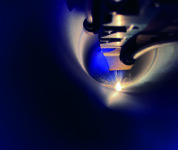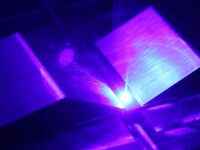Mülheim-Kärlich, March 19, 2025 – In the industrial production of lithium-ion batteries, electrode drying was previously one of the most critical sub-processes. The high energy and time consumption, as well as the significant space requirements made the drying of the active paste (slurry) applied to a current conductor foil in the roll-to-roll process (R2R) one of the most cost- and CO2-intensive manufacturing steps in the entire battery production process. Against this background, the IDEEL (Implementation of Laser Drying Processes for Economical & Ecological Lithium-Ion Battery Production) research project, which was completed on December 31, 2024 after three years of research, explored alternative drying processes using highly efficient large-area laser irradiation. The project was supported by the German Federal Ministry of Education and Research as part of the Battery 2020 funding program and was coordinated by Laserline GmbH. Additional project partners included the Chair of Production Engineering of E-Mobility Components (PEM) at RWTH Aachen University, Coatema Coating Machinery GmbH, Optris GmbH & Co. KG, the Fraunhofer Institute for Laser Technology (ILT), the Münster Electrochemical Energy Technology (MEET) Battery Research Center at the University of Münster and the Fraunhofer Research Institution for Battery Cell Production FFB.
Development and Optimization of Laser Drying as a Project Focus
The initial focus of the IDEEL research cooperation was the development and gradual optimization of a suitable laser drying process. To this end, materials for anode and cathode coatings were specifically validated for laser application, and aqueous formulations based on graphite, lithium iron phosphate and silicon graphite were successfully tested (PEM at RWTH Aachen University, MEET Battery Research Center at the University of Münster). A highly efficient diode laser system with a wall plug efficiency of over 50 percent and new processing head with coaxial thermographic coupling and a rectangular laser spot over 0.5 meters wide (Laserline) served as the heat source. To enable contactless, automated process monitoring and control, a highly integrated thermographic camera with industry PC-compatible data output was developed. This system ensures consistent target temperature maintenance even with varying web speeds and coating thicknesses (Optris, Laserline, Fraunhofer ILT). Based on these system components, a modular laser drying unit was developed as a demonstrator, featuring a specialized air management concept and custom dual-chamber wide-slot nozzles for the fast and reliable application of water-based battery pastes (Coatema). Within this demonstrator, the laser-based R2R drying process was upscaled to industrially relevant feed rates while simultaneously determining and validating the optimal process configuration (Fraunhofer ILT, Fraunhofer FFB).
Hybrid Process Enables Industrial Scaling
Since drying requires both heating and mass transport via air extraction, the most technically and economically promising approach was to implement a hybrid configuration with hot air and laser modules. In this R2R process configuration, laser drying enables rapid heating and pre-drying of the slurry, while a downstream convection oven prolongs temperature exposure, ensuring thorough drying of the electrode coating. This approach also allows existing facilities to benefit from the new method by retrofitting laser modules, combining technical optimization with the sustainable use of capital goods. As part of this effort, the project partners developed an innovative hybrid drying system that, for the first time, achieves a web speed of 30 meters per minute and reduces drying times by more than 60%. Additionally, the laser booster at the start of the process cuts the required oven length in half, saving valuable production space and significantly reducing the demand for energy-intensive dry rooms. The operational costs of the drying process decrease by 20 to 30% overall. Furthermore, the reduced oven operation, coupled with the ongoing utilization of a retrofitted system throughout its remaining lifecycle, results in a substantial enhancement of the overall CO₂ footprint. This new approach enables more cost-effective and environmentally friendly processes, which in turn significantly enhances the economic and ecological balance of battery production.
Studies Confirm Equivalent Results with Increased Throughput
Experimental studies conducted by Fraunhofer ILT, PEM of RWTH Aachen University, MEET Battery Research Center, and Fraunhofer FFB demonstrated that the results of hybrid drying are equivalent to those of established convection drying. Despite increased throughput rates, the quality of electrode performance remains at least equivalent in terms of adhesion, residual moisture, electrical conductivity, and electrochemical properties. The industrial relevance of the newly developed process is thus fully validated. The process insights developed within the IDEEL project will consequently be incorporated into the work of Fraunhofer FFB, which is set to become a development center for modern battery cell production in Germany and its European partners.
| IDEEL Project:
The research project “IDEEL” is funded as part of the BMBF program Batterie2020 by the Federal Ministry of Education and Research (BMBF) under the funding code 03XP0414A through the project management organisation Project Management Jülich (Forschungszentrum Jülich GmbH). The project partners are Laserline GmbH, Coatema Coating Machinery GmbH and Optris GmbH, as well as the Fraunhofer Institute for Laser Technology (ILT), the Fraunhofer Research Institution for Battery Cell Production (FFB), the Münster Electrochemical Energy Technology (MEET) Battery Research Center at the University of Münster and the Production Engineering of E-Mobility Components (PEM) at RWTH Aachen University. The aim of the three-year project is to develop an industry-relevant laser drying process that will enable series production of lithium-ion batteries that is both more climate-friendly and economical. Initially, a new electrode paste optimized for laser use will be developed as a coating material (PEM, MEET), a highly efficient laser system with a large-area, homogeneous spot (Laserline) and a highly integrative thermographic camera for contactless process monitoring (Optris, Laserline, Fraunhofer ILT). Based on these contributions, the laser-based drying process will be scaled up to industry-typical feed rates within a demonstrator (Coatema) and the physics-based model of the new drying process subsequently validated (ILT, FFB).
The research results are to be incorporated into the FFB’s processes in the future. The work of the FFB is considered one of the flagship projects of German battery research and is expected to become the principle development center of modern battery cell production for both Germany and European partners, with the goal of reducing German and European manufacturing dependence on the world market. A complete production infrastructure is therefore currently being built at the Münster site, with the intention of providing support to companies and research institutions seeking to test and optimize the series production of new battery designs. |
| Laser drying in the context of battery production:
The drying process addressed by the IDEEL project is part of the electrode manufacturing process for high-power battery cells, such as those used in electric vehicles and home storage systems. It is used to dry an electrode paste (slurry), which consists of a specially adjusted, homogeneous active material mixture and is applied to the copper foil of the battery electrode. Up to now, convection dryers have been used to dry this electrode coating, but the thermal energy transfer is only indirect into the material and thus places a heavy burden on both the CO2 balance and the energy costs of battery production. The IDEEL project partners are therefore focusing on up-scaling a more energy-efficient drying process in which the coating is irradiated using high-power diode lasers. The process benefits from the strong absorption of infrared laser light in the coating material, allows for more flexible and precise process control compared to common convection technology, and where the IDEEL project ultimately aims to demonstrate web speeds of up to 30 meters per minute. The compact design and efficient energy transfer are expected to significantly ease the extensive space requirements of the drying sections, which are typically more than 100 meters long – with a significantly reduced spatial footprint for the production environment, the planning of new production systems should enable faster and more energy-efficient process control. |











